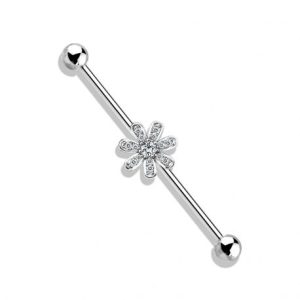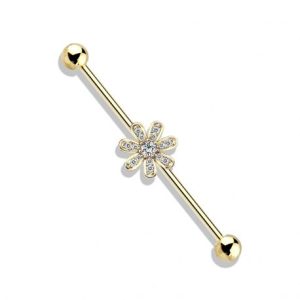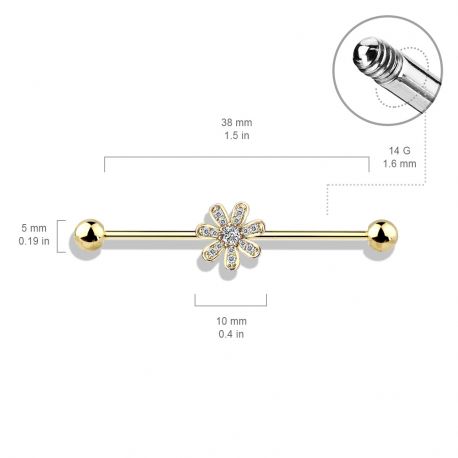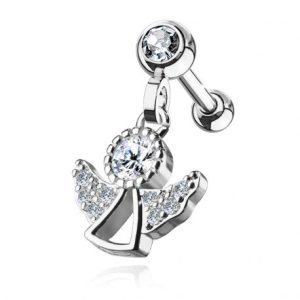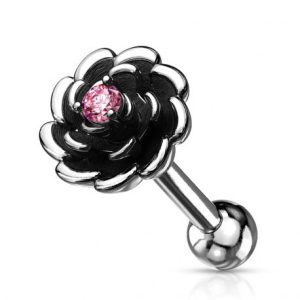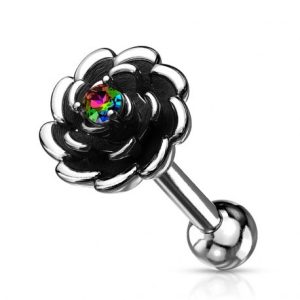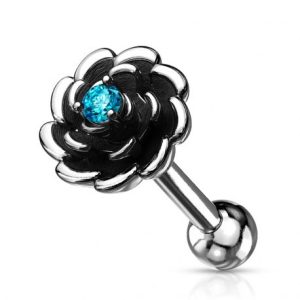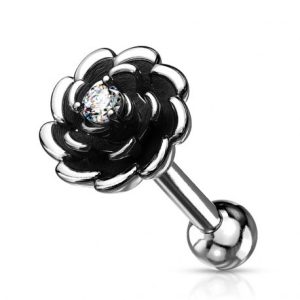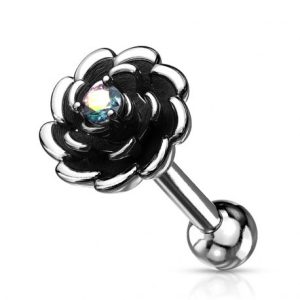Helix Piercing
Helix Piercing: The Ultimate Guide for a Stylish and Safe Experience
Helix piercing has become an increasingly popular choice among body art enthusiasts looking for a unique and stylish way to express themselves. This type of piercing is located on the outer edge of the ear, usually along the upper cartilage, and offers a wide range of customization options. In this comprehensive guide, we’ll cover all aspects of helix piercing, including the different types, the piercing process, post-operative care, potential risks and helpful tips to ensure a successful and enjoyable experience.
What is Helix Piercing?
A helix piercing, also known as a cartilage piercing, is situated on the outer cartilage of your ear. This trendy ear piercing adds a distinctive and fashionable touch to your appearance, allowing for a wide array of jewelry choices. There are several variations of the helix piercing, including the forward helix, double helix, triple helix, and anti-helix (or snug) piercings. Each type is distinguished by its specific location on the ear, ensuring that you can find the perfect helix piercing to match your personal style.
Types of Helix Piercing
There are several variations of helix piercings, each offering its own distinct aesthetic appeal. With numerous placements and designs available, these piercings can be a subtle addition or a bold statement piece.
| Type of Helix Piercing | Placement | Pricing | Pain Level (1-10) | Healing Time | Aftercare |
|---|---|---|---|---|---|
| Standard Helix Piercing | The outer rim of the upper ear | $30-$75 | 4-7 | 3-6 months | Wash the piercing twice daily with a saline solution or antimicrobial soap; avoid irritation. |
| Low Helix Piercing | The lower part of the helix | $30-$75 | 4-7 | 3-6 months | Wash the piercing twice daily with a saline solution or antimicrobial soap; avoid irritation. |
| Forward Helix Piercing | Front side of the helix | $30-$75 | 4-7 | 3-6 months | Wash the piercing twice daily with a saline solution or antimicrobial soap; avoid irritation. |
| Double Helix Piercing | Two piercings along the helix | $60-$150 | 4-7 (each piercing) | 3-6 months | Wash the piercing twice daily with a saline solution or antimicrobial soap; avoid irritation. |
| Triple Helix Piercing | Three piercings along the helix | $90-$225 | 4-7 (each piercing) | 3-6 months | Wash the piercing twice daily with a saline solution or antimicrobial soap; avoid irritation. |
-
Standard Helix Piercing
The standard helix piercing is the most prevalent type and can be placed anywhere along the outer rim of the upper ear. Typically adorned with a small stud or hoop, this piercing is a popular choice for those venturing into helix piercings for the first time. The simplicity of the standard helix piercing makes it a versatile and timeless option.
-
Low Helix Piercing
As the name suggests, a low helix piercing is located lower on the helix of the ear, closer to the earlobe. This is in contrast to a standard helix piercing, which is typically located in the upper part of the helix. The types of jewelry that can be used for a low helix piercing are similar to those used for a standard helix piercing. This includes small hoop earrings, studs, and barbells.
@mirrdo.piercings if u wanna say something, say it now 👇ðŸ½ðŸ¤ðŸ’œ #helixpiercing #earpiercings #piercing #mirrdopiercings #piercingrotterdam #piercingstudio #piercingvideos #piercingcloseup ♬ Say Something – Zac Samuel Remix – Karen Harding
-
Forward Helix Piercing
A forward helix piercing is situated on the front side of the helix, close to the head. This unique placement allows for a distinctive and fashionable look. The forward helix piercing can also be done in single, double, or triple variations, enabling you to create a personalized style statement.
-
Double Helix Piercing
A double helix piercing consists of two piercings in a row along the helix. This option adds an extra layer of complexity and visual interest to the ear, as the two piercings can be adorned with coordinating jewelry. The double helix piercing is perfect for those seeking a more intricate and attention-grabbing appearance.
-
Triple Helix Piercing
For those who want to make an even bolder statement, the triple helix piercing features three piercings in a row along the helix. This striking arrangement allows for an elaborate and eye-catching look, as you can mix and match different jewelry styles or opt for a cohesive set. The triple helix piercing showcases your creative and adventurous spirit, making it a memorable choice.
@mirrdo.piercings which piercing should we do next in a video? 👀 let us know down below! 🔮💜 #helixpiercing #forwardhelix #mirrdopiercings #piercingrotterdam ♬ Baby Work It – Your Favourite Garçon
Preparation for Helix Piercing
Embracing the excitement of getting a helix piercing can be an exhilarating experience, but it’s essential to prepare yourself properly to ensure the process goes smoothly.
-
Choosing a Professional Piercer
It is crucial to select a reputable and experienced piercer to ensure a safe and successful helix piercing. Look for a professional who operates in a clean, sterile environment, has the necessary certifications, and proudly displays their portfolio. The skill and expertise of your chosen piercer will play a significant role in your overall experience.
-
Knowing the Risks
Before taking the plunge, it is essential to know the potential risks associated with helix piercings. These can include infections, keloids and prolonged healing time. Discuss these risks openly and honestly with the piercer of your choice so you can make an informed decision with confidence.
-
Preparing Yourself
Preparing yourself mentally and physically for the piercing is a crucial step. Make sure you are well rested, hydrated and have eaten a meal before your appointment. This will help you minimize discomfort during the piercing process and promote healing after the piercing. Also, avoid using alcohol or drugs before your appointment, as these substances can negatively impact the piercing process and your body’s ability to heal.
How much does a helix piercing cost?
Taking the plunge and getting your helix pierced can be an exhilarating decision, but it is essential to keep in mind the costs involved. The price of a helix piercing can vary greatly depending on factors such as the location of the piercing studio, the expertise of the piercer and the type of jewelry you choose. As a general rule, you should expect to pay between $30 and $75 for the procedure.
The Helix Piercing Process
The process for obtaining a helix piercing is relatively straightforward. The long awaited moment has finally arrived. Your professional piercer will begin by meticulously cleaning your ear and marking the precise location where the helix piercing will be placed. With a gentle but firm hand, he will use a sterilized hollow needle to create the hole. The final step is to insert the beautiful jewelry you have chosen for your new piercing. In the blink of an eye, the procedure is complete and usually only takes a few minutes.
Do helix piercings hurt?
The pain associated with helix piercings largely depends on your personal tolerance levels. Generally, helix piercings are considered to be a bit more painful than lobe piercings due to the difference in tissue density. Cartilage is denser, requiring more force for the needle to pass through, which can result in increased discomfort. However, it’s essential to remember that pain is subjective, and everyone’s experience may vary. To minimize pain, consider your own pain threshold and choose a skilled, experienced piercer. While it’s true that any piercing will come with some degree of discomfort, the pain is temporary, and you’ll be left with a stunning, long-lasting accessory.
How long does it take for a helix piercing to heal?
Healing from a helix piercing is a unique and personal experience that depends on factors such as your overall health, sleep and stress levels, and the aftercare routine you follow. Our bodies respond differently to physical stressors, so it’s no surprise that the healing time can vary from person to person. On average, the initial healing period for a helix piercing takes about two to four months. However, it may take six to nine months for the piercing to be fully healed.
During the healing process, it’s essential to take care of your piercing to ensure a smooth recovery. If you neglect proper aftercare, the healing time may be prolonged, or you might even need to get the piercing redone. Once primary healing is complete, usually around three months, you can switch jewelry, reduce aftercare measures, and engage in activities like swimming. The following nine months are crucial for secondary healing, allowing the fistula (the tube of new tissue inside the piercing) to mature and stabilize.
Remember, patience is key when it comes to helix piercings. Give your body the time it needs to heal, and before you know it, you’ll be able to enjoy your new accessory without any worries!
Helix Piercing Aftercare
As your helix piercing starts to heal, you’ll notice a decrease in pain. It’s essential to practice proper aftercare to ensure that your new accessory not only looks fantastic but feels great too. The golden rule during the healing process is to keep your hands off the fresh piercing. Avoid touching or twisting it and make sure to clean it with a saline solution no more than twice a day. Be cautious of snags and avoid sleeping on the pierced side, as this can disrupt the healing process.
When it comes to cleaning, stick to saline solutions, as the salt helps draw out excess discharge while increasing blood circulation. Steer clear of rubbing alcohol, hydrogen peroxide, and ointments, as these can dry out and further irritate your piercing, prolonging the total healing time. Washing the piercing twice a day with saline solution (or antimicrobial soap) is crucial, but the real challenge is avoiding any irritation to the piercing. Limit friction by avoiding accessories that could snag on it, like beanies or headphones. If you’re a side-sleeper, it is better to sleep on the opposite side of the pierced ear to prevent complications.
It’s also vital to minimize touching or disturbing your piercing, as irritation could lead to inflammation or even infections. If you absolutely need to touch your piercing, always wash your hands beforehand. Taking care of your piercing during the healing process can be summed up with this simple principle: never apply anything to your piercing that you wouldn’t put in your eyes. By adhering to these guidelines, you’ll be well on your way to a beautifully healed helix piercing.
Potential Risks and Complications
As with any body modification, helix piercings carry some potential risks and complications. Awareness of these issues can help you take necessary precautions and address any concerns promptly. Some potential risks include:
- Infection: Bacterial infections can occur if proper aftercare is not followed or if the piercing is exposed to contaminants.
- Keloids: These raised scars can form around the piercing site in some individuals, particularly those with a genetic predisposition to keloid formation.
- Migration or Rejection: In rare cases, the body may reject the piercing, causing the jewelry to migrate or be pushed out entirely.
- Cartilage Bumps: Small, benign bumps may develop around the piercing site, often due to irritation or an allergic reaction to the jewelry material.
- Nerve Damage: Though uncommon, nerve damage can occur if the needle comes into contact with a nerve during the piercing process.
Choosing the Right Jewelry for Your Helix Piercing
Selecting the appropriate jewelry for your helix piercing is crucial for both style and safety.
Here are some popular types of helix piercing jewelry and their characteristics:
- Studs: A stud is a small piece of jewelry with a thin, elongated backing that is inserted into the hole of a piercing. To secure a stud in place, a small fixture is attached on the other side. Studs come in various shapes, such as stars, hearts, or even tiny gems, and they create a subtle and elegant look.
- Hoops/Rings: These are popular choices for helix piercings, as they are flexible metal pieces shaped like a ring. To remove a hoop, simply pull apart the two ends. Hoops come in various sizes and thicknesses, offering a timeless appeal. You can choose from simple, sleek hoops or more intricate designs with beads or dangling charms.
In addition to these types, there are other options like huggies, captive bead rings, curved barbells, and clickers, which provide a diverse range of styles to suit your preferences. Materials range from surgical steel and titanium to gold and even biocompatible plastic.
Express Yourself with Stylish Helix Piercings
Dive into a realm of exceptional body jewelry with our exquisite helix piercing collection, where each piece is meticulously selected to cater to your desire for self-expression, sophistication, and individuality.
The allure of our mesmerizing helix piercings appeals to body jewelry connoisseurs and newcomers alike, looking to upgrade their style. With a variety of captivating designs – from minimalist barbells to intricate rings adorned with sparkling gems and eye-catching charms – you’ll revel in decorating your ears with these stunning pieces, making you stand out from the crowd.
Our collection offers an assortment of colors, materials, and styles – including gold, silver, titanium, and stainless steel – to guarantee that each piece harmonizes with your personal aesthetic.
Frequently Asked Questions (FAQs)
Can I change my helix piercing jewelry by myself?
It’s best to wait until the piercing has fully healed before attempting to change the jewelry. If you’re unsure about how to change it, consult your piercer for assistance.
How do you sleep with a helix piercing?
To sleep with a helix piercing, use a travel pillow or donut-shaped pillow to keep pressure off the piercing, or try sleeping on the opposite side of the pierced ear to minimize irritation and promote healing.
Can I get multiple helix piercings at once?
Yes, it is possible to get multiple helix piercings during a single session. However, consider the additional healing time and potential discomfort before making this decision.
How can I prevent an infection in my helix piercing?
To minimize the risk of infection, follow your piercer’s aftercare instructions, keep the area clean, and avoid touching the piercing with dirty hands. If you notice any signs of infection, such as increased redness, swelling, or discharge, consult your piercer or a healthcare professional immediately.

